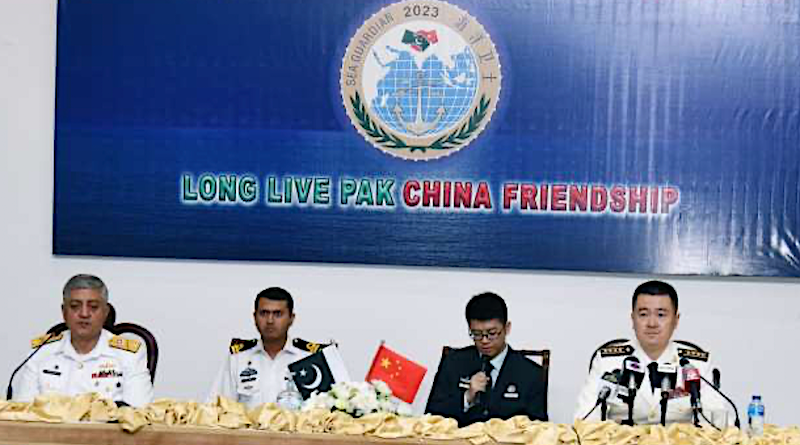Deciphering China-Pakistan Naval Exercises In The Indian Ocean – Analysis

What is special about China-Pakistan maritime exercises in the Northern Arabian Sea? Not much, one might plausibly argue. The two countries regularly perform naval drills in the Indian Ocean, with the Sea Guardian exercises now an annual feature. Normally, the exercises are held in waters close to Pakistan and rarely in ways that directly challenge Indian interests. Whatever the rhetoric surrounding China-Pakistan military cooperation, Beijing has so far refrained from establishing a permanent naval presence in Pakistan.
Why, then, has there been so much interest around Sea Guardian-3 held last week in the Northern Arabian Sea? Pakistani hype, it seems, is the reason, with Pakistan naval commanders playing up the exercises as the first joint maritime patrol between China and Pakistan.
According to reports, the two sides observers on each other’s participating units, including a Chinese observer on a Pakistani anti-submarine patrol aircraft.
For context, this is the third time that the PLAN and Pakistan Navy (PN) have come together for the “Sea Guardian” exercises. The two earlier iterations, in January 2020 (in the northern Arabian Sea) and in July 2022 (in the East China Sea), were regular engagements but they were preceded by annual bilateral exercises between the two navies that had been ongoing since 2014. What seems to have caused some speculation this time around is that the exercise came a day after the 2+2 Ministerial dialogue between India and the U.S. where maritime security in the Indo-Pacific was a major topic of discussion. With New Delhi announcing its decision to become a full member of the Bahrain-based US-led multilateral grouping Combined Maritime Forces, China, Indian analysts surmise, is keen to signal its strategic intent to counter United States and Indian moves in the Indian Ocean.
The PN is undergoing a programme of modernisation, a seeming response to the Indian Navy’s (IN) growing power and presence in the Indian Ocean. Pakistan’s naval leadership continues to view the IN with suspicion. The latter’s sustained growth in recent years is a key driver of the PN’s development and expansion of assets.
The PN is also leery of the IN’s propensity to besiege Pakistan’s Makran coast during times of political crisis between India and Pakistan. During Operation Vijay in 1999 and Operation Parakram in 2001, the IN deployed warships in the Northern Arabian Sea, establishing what Indian analysts termed a loose blockade. More recently, in 2019, immediately after a terror attack in Pulwama, India positioned a fleet of warships close to Pakistani territorial waters. The deployment was meant to signal Indian resolve, but the PN saw it as an overly aggressive move.
Part of the problem for India is the entrenched perception among Pakistan’s strategic elite that a limited conventional war between India and Pakistan remains more—rather than less—likely. Khalid Kidwai, Director General of Pakistan’s Strategic Plans Division, suggests that as the weaker state in the dyad, Pakistan’s sensitivities are more fraught than India’s. Islamabad, he contends, is obliged to use every tool in its strategic toolkit (sub-conventional to conventional and nuclear) to target India, which, he avers, has aggressive designs and uses strategies like ‘Cold Start’ to provoke Pakistan. Such talk may seem delusional to Indian observers but for Pakistani commanders, it is an article of faith.
It should interest Indian observers that in May this year, China completed delivery of all four Type 054A/P guided missile frigates to the Pakistani Navy. Pakistan is all set to acquire eight Yuan-class submarines from China, with four of them scheduled for delivery by the end of 2024. Turkey, meanwhile, has delivered the first of Babur-class corvettes, also known as the PN MILGEM class, to the Pakistan Navy. Pakistan and Türkiyé are also co-developing the Jinnah-class frigate, the construction for which will begin after the completion of the order for Babur-class corvettes by the state-owned Karachi shipyard. The entire effort appears geared to make the PN a potent force in the Indian Ocean.
Yet, it would be a mistake for Indian observers to regard the PN in purely adversarial terms. It is today more conceptually evolved than earlier and not solely focused on countering India. Pakistan’s 2018 maritime doctrine describes the Indian Ocean Region (IOR) as “a strategic space where the interests of many regional and extra-regional powers intersect” and where a cooperative approach is the best way forward. As Pakistan’s naval planners see it, the IOR is critical for the economic and military power balance, which requires the Pakistan navy to position itself as a regional player and security provider in the region.
Beyond preserving a “threat-free environment” for Pakistan—a seeming reference to the challenge posed by India—the PN’s Aman exercises (held biennially) and the Regional Maritime Security Patrols instituted in 2020 seek to expand Pakistan’s diplomatic space in the Indian Ocean. This is partly the logic underlying Pakistan’s bilateral and multilateral naval engagements. The PN is well aware that the IN seeks to exclude it from collaborative frameworks in the Indian Ocean. Despite being a member of the 25-member Indian Ocean Naval Symposium, the PN was not invited by India for the group’s 10-year celebrations in 2022. The PN’s bid to invest in partnerships in the Indian Ocean is a way of counteracting the IN’s growing influence.
The last thing Pakistan’s naval planners would like to see is for India to seize the strategic initiative in the Indian Ocean. China is Pakistan’s best bet to push back against Indian dominance of the littoral. Contrary to what many in New Delhi might imagine, China-Pakistan naval engagement is about competitive diplomacy in the Indian Ocean rather than Chinese (or Pakistani) power projection in India’s maritime neighbourhood.
